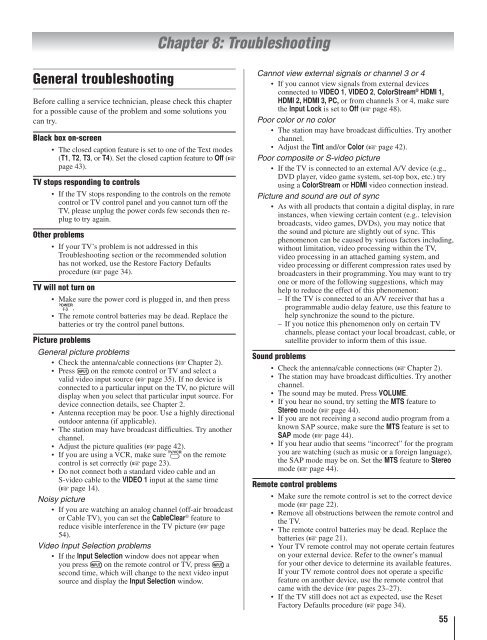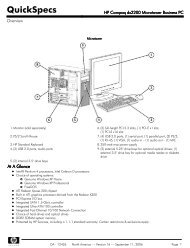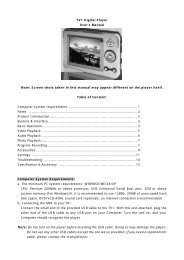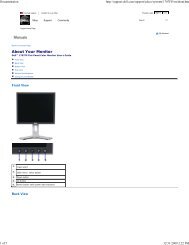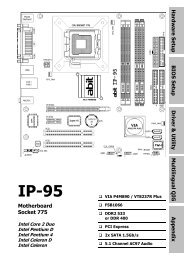Toshiba 40RV525R PDF Manual - static.highspeedb...
Toshiba 40RV525R PDF Manual - static.highspeedb...
Toshiba 40RV525R PDF Manual - static.highspeedb...
You also want an ePaper? Increase the reach of your titles
YUMPU automatically turns print PDFs into web optimized ePapers that Google loves.
General troubleshooting<br />
Before calling a service technician, please check this chapter<br />
for a possible cause of the problem and some solutions you<br />
can try.<br />
Black box on-screen<br />
The closed caption feature is set to one of the Text modes<br />
(T1, T2, T3, or T4). Set the closed caption feature to Off (<br />
page 43).<br />
TV stops responding to controls<br />
If the TV stops responding to the controls on the remote<br />
control or TV control panel and you cannot turn off the<br />
TV, please unplug the power cords few seconds then replug<br />
to try again.<br />
Other problems<br />
If your TV’s problem is not addressed in this<br />
Troubleshooting section or the recommended solution<br />
has not worked, use the Restore Factory Defaults<br />
procedure ( page 34).<br />
TV will not turn on<br />
Make sure the power cord is plugged in, and then press<br />
.<br />
The remote control batteries may be dead. Replace the<br />
batteries or try the control panel buttons.<br />
Picture problems<br />
General picture problems<br />
Check the antenna/cable connections ( Chapter 2).<br />
Press on the remote control or TV and select a<br />
valid video input source ( page 35). If no device is<br />
connected to a particular input on the TV, no picture will<br />
display when you select that particular input source. For<br />
device connection details, see Chapter 2.<br />
Antenna reception may be poor. Use a highly directional<br />
outdoor antenna (if applicable).<br />
The station may have broadcast difficulties. Try another<br />
channel.<br />
Adjust the picture qualities ( page 42).<br />
If you are using a VCR, make sure on the remote<br />
control is set correctly ( page 23).<br />
Do not connect both a standard video cable and an<br />
S-video cable to the VIDEO 1 input at the same time<br />
( page 14).<br />
Noisy picture<br />
If you are watching an analog channel (off-air broadcast<br />
or Cable TV), you can set the CableClear ® feature to<br />
reduce visible interference in the TV picture ( page<br />
54).<br />
Video Input Selection problems<br />
If the Input Selection window does not appear when<br />
you press on the remote control or TV, press a<br />
second time, which will change to the next video input<br />
source and display the Input Selection window.<br />
Chapter 8: Troubleshooting<br />
Cannot view external signals or channel 3 or 4<br />
If you cannot view signals from external devices<br />
connected to VIDEO 1, VIDEO 2, ColorStream ® HDMI 1,<br />
HDMI 2, HDMI 3, PC, or from channels 3 or 4, make sure<br />
the Input Lock is set to Off ( page 48).<br />
Poor color or no color<br />
The station may have broadcast difficulties. Try another<br />
channel.<br />
Adjust the Tint and/or Color ( page 42).<br />
Poor composite or S-video picture<br />
If the TV is connected to an external A/V device (e.g.,<br />
DVD player, video game system, set-top box, etc.) try<br />
using a ColorStream or HDMI video connection instead.<br />
Picture and sound are out of sync<br />
As with all products that contain a digital display, in rare<br />
instances, when viewing certain content (e.g.. television<br />
broadcasts, video games, DVDs), you may notice that<br />
the sound and picture are slightly out of sync. This<br />
phenomenon can be caused by various factors including,<br />
without limitation, video processing within the TV,<br />
video processing in an attached gaming system, and<br />
video processing or different compression rates used by<br />
broadcasters in their programming. You may want to try<br />
one or more of the following suggestions, which may<br />
help to reduce the effect of this phenomenon:<br />
– If the TV is connected to an A/V receiver that has a<br />
programmable audio delay feature, use this feature to<br />
help synchronize the sound to the picture.<br />
– If you notice this phenomenon only on certain TV<br />
channels, please contact your local broadcast, cable, or<br />
satellite provider to inform them of this issue.<br />
Sound problems<br />
Check the antenna/cable connections ( Chapter 2).<br />
The station may have broadcast difficulties. Try another<br />
channel.<br />
The sound may be muted. Press VOLUME.<br />
If you hear no sound, try setting the MTS feature to<br />
Stereo mode ( page 44).<br />
If you are not receiving a second audio program from a<br />
known SAP source, make sure the MTS feature is set to<br />
SAP mode ( page 44).<br />
If you hear audio that seems “incorrect” for the program<br />
you are watching (such as music or a foreign language),<br />
the SAP mode may be on. Set the MTS feature to Stereo<br />
mode ( page 44).<br />
Remote control problems<br />
Make sure the remote control is set to the correct device<br />
mode ( page 22).<br />
Remove all obstructions between the remote control and<br />
the TV.<br />
The remote control batteries may be dead. Replace the<br />
batteries ( page 21).<br />
Your TV remote control may not operate certain features<br />
on your external device. Refer to the owner’s manual<br />
for your other device to determine its available features.<br />
If your TV remote control does not operate a specific<br />
feature on another device, use the remote control that<br />
came with the device ( pages 23–27).<br />
If the TV still does not act as expected, use the Reset<br />
Factory Defaults procedure ( page 34).<br />
55


